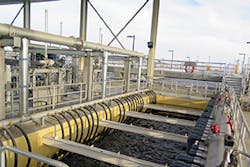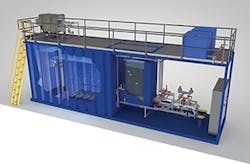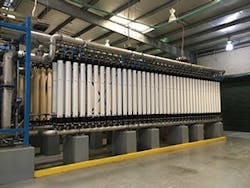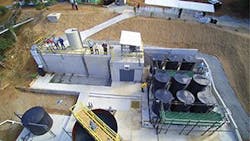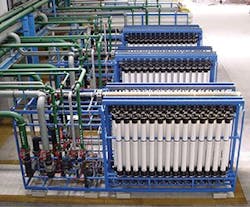Wastewater treatment plants are impacted by the same infrastructure issues as highways, bridges, and municipal water systems. As population increases and permitting requirements are strengthened, there is little room to upgrade and expand. Costs are also prohibitive. New technologies like membrane bioreactors (MBR), however, can fit in the footprint of an existing plant, expand it, and respond to local, regional, and national permitting requirements at the same time.
Wastewater treatment plants are not all alike. They are designed to provide treatment for a particular region or location which has unique permitting requirements. These requirements drive technology, says Mike Snodgrass, membrane technology leader for Ovivo Water.
Snodgrass says the basic process of wastewater treatment is to grow microorganisms with oxygen, then separate out the unwanted bugs via gravity. “But it doesn’t get you the quality of water you want,” he says. Membrane bioreactors, his specialty, do the same thing without gravity, instead using a filter to capture the bugs and remove them. In an existing conventional wastewater plant, adding an MBR and quadrupling the process adds up to huge cost savings.
MBR is a recent technology development beginning in the early 2000s, says Snodgrass. An installation takes up two to four times less space and has a higher level of treatment producing higher-quality water. However, the cost will depend on the level of treatment, and a discharge permit will determine this. New requirements to treat wastewater to higher levels would require a conventional plant to increase the treatment process, adding expense. An MBR would guarantee reaching the required discharge levels, Snodgrass explains.
EVOQUA INNOVATES
Evoqua Water Technologies is a new name but it has a long history, having evolved from the Link-Belt company beginning in 1874 to become Siemens Water Technologies. It was spun off from the parent company in 2014 and renamed.
Evoqua, headquartered in Pittsburg, PA, continues to supply OEM parts for all of the brands that were acquired through those years and today for virtually the whole wastewater technology chain.
The extensive list of technologies on Evoqua’s website is impressive. This reflects the different needs at thousands of wastewater treatment plants across the country, which differ in the type of effluent, location, and the regulatory requirements of different treatment schemes.
Marc Roehl is the vice president and general manager of Evoqua’s wastewater treatment business. He says the industry continues to look for technologies that use less energy. Aeration is the biggest energy user and Evoqua continues to look for technologies that use as little energy as possible across the wastewater process.
The membrane bioreactor provides filtration with activated sludge, waste oxidation, and membrane separation. Roehl says it has been around since the 1990s and continues to be developed. Evoqua developed its latest version, MemPulse MBR, which has few maintenance requirements, in the 2000s along with Xpress MBR.
MemPulse utilizes no moving parts during the membrane air-scour process. It features a modular design and can be used for parks and resorts, turnkey projects, and water reuse. The Xpress MBR is a small-flow bioreactor package plant that is pre-assembled in-house and then shipped to the client on a pad. It is an MBR that reduces energy and maintenance costs. It also saves space due to its compact design.
OTHER SECONDARY CLARIFIERS
The BioMag ballasted settling system is similar to that of the MBR and is applied to the secondary clarifier. It, along with CoMag, infuses magnetite as a weighting agent into biological floc (BioMag) or chemical floc (CoMag).
BioMag and MBR both have higher treatment capacity and relatively high performance in smaller spaces. The choice of footprint depends on effluent input. The two technologies are normally not installed together, says Roehl, but could be to compress plant footprint.
The advantage MBR offers is its barrier on effluent, allowing it to produce reuse-quality water in compliance with California’s Title 22 requirements. BioMag technology would require a filter in the back of it to produce reuse water. The BioMag is generally less costly but not always, says Roehl, and it depends on the site requirements and application.
Roehl says the CoMag Particulate Removal System was developed about 10 years ago and with it, solids settle faster in primary treatment due to the magnetite. Its application is ideal for industrial discharge or in dense populations and for tertiary treatment and stormwater management. It is NSF-approved for drinking water applications.
The Orbal system also uses an activated sludge process and provides enhanced biological nutrient removal with suspended growth. It operates as a simultaneous nitrification/denitrification process. Roehl says it has been around since the late 1960s and 1970s when the technology was developed. Evoqua has come out in the past two or three years with a new aerator device for it that has reduced capital costs by doubling oxygen transfer to reduce maintenance and construction. Roehl says Orbal is similar to the MBR but it is a conventional process and aerates with disc operators. Unlike MBR, it has no membranes. Its advantage is that it can run with low energy requirements. “It effectively delivers oxygen at low cost,” he says. Applications include biological phosphorus removal and stormwater treatment, particularly in high storm areas.
Evoqua Water Technologies XPRESS MBR is a small-flow bioreactor package plant that reduces energy and maintenance costs. It is pre-assembled in-house and shipped to clients.
DAF & CAPTIVATOR
Another technology Evoqua offers is the Dissolved Air Flotation (DAF) clarifiers, which treat both screened raw sewage and waste-activated solids before entering a bioreactor. Roehl says it is a fairly old technology going back 40 years and has seen improvements in the last five to 10 years.
The Agua Nueva Water Reclamation Facility produces 32 million gallons of high-quality reclaimed water daily. It started up in late 2014 in Tucson, AZ, at a cost of $172 million. It was built by the Pima County Regional Wastewater Reclamation Department in response to requirements by Arizona regulators to reduce the nitrogen in its wastewater by January 2015 as part of its Regional Optimization Master Plan.
It installed the DAF system partnered with Evoqua’s Captivator, which some consider the first large-scale primary clarifier in the world, using DAF for primary treatment. It was designed, built, and is operated by CH2M HILL. The DAF applied to the liquid stream removes and thickens the majority of biomass and incoming sludge at high overflow rates.
According to the case study available on the Evoqua website, the DAF primary clarifiers treat both the screened raw sewage and the waste-activated solids that are combined at the head of each DAF unit. They were found to remove between 50% and 75% of the suspended material, depending on chemical addition.
The Captivator system captures and converts biochemical oxygen demand to biogas. It can be the sole primary treatment for a new plant installation and, according to Evoqua, “helps to gain 65% more biogas while requiring only 44% aeration for chemical oxygen demand oxidation.”
Scinor’s Thermal Induced Phase Separator (TIPS) ultrafiltration hollowfiber membrane installed as a retrofit in a Temple, TX, water treatment plant
According to Evoqua, the Captivator system can help wastewater treatment plants to approach energy neutrality by diverting more organics for biogas production and reducing the energy requirements for aeration. Furthermore, it can help reduce the installation footprint for primary treatment and save considerable capital costs by eliminating the sludge thickening process.
The resulting reclaimed water irrigates the city’s park, golf courses, and other turf facilities, reducing diversion of water from sensitive habitats. With significantly reduced nitrogen levels, flora and fauna are returning to the river.
TIPS FROM SINCOR
Scinor manufactures its patented Thermally Induced Phase Separation (TIPS) ultrafiltration, hollow-fiber membrane for use in drinking water, wastewater, and industrial water treatment applications worldwide.
TIPS is manufactured from polyvinylidene fluoride (PVDF) making it more robust, chemically tolerant, and permeable than its competitors, says Joe Tardio, vice president of sales. It was developed by scientists at the Tsinghua University in Beijing. Tardio says TIPS is a direct retrofit product and has introduced competition into a previously closed market due to its superior membrane in direct retrofit configurations.
Tardio says traditionally, many end-users have been limited to selecting membrane treatment systems from proprietary system suppliers. When users wanted to replace an item, they had to return to the manufacturers of the installed product to replace it. Tardio says this led to a proliferation of “open platform” or universal systems on the market, but the TIPS direct retrofit membrane offers a higher quality solution for all major membrane suppliers, he says.
TIPS is ideal for secondary and tertiary wastewater treatment, says Tardio. Scinor membranes can also be used to treat spent filter backwash from multimedia and primary membrane filtration systems. It is more chemically tolerant, mechanically stronger, more permeable, and has a longer service life and lower capital and operational costs, he says.
The company’s largest US TIPS installation to date is at the Edward C. Little Water Recycling Facility in El Segundo, CA. The West Basin Municipal Water District, a wholesale water agency, built the water recycling treatment facility starting in 1992 following California’s early drought period in the late 1980s and early 1990s. Built in phases, it now produces 40 million gallons per day from secondary wastewater effluent imported from the Hyperion Water Treatment Facility operated by the Los Angeles Bureau of Sanitation.
Fluence Corporation developed the membrane aerated biofilm reactor beginning in 2008. Its first US installation as a wastewater treatment plant is in Bordeaux, St. Thomas, US Virgin Islands.
Among the designer waters the recycling facility produces for customers, it filters treated wastewater effluent by microfiltration and reverse osmosis membranes and disinfects it for use in maintaining a barrier against seawater intrusion and augmenting local well water supplies. Low-pressure boiler feed water is also produced from sewer water and filtered by microfiltration and reverse osmosis membranes. For high-pressure boiler feed water, the technique is the same but the water is passed through reverse osmosis membranes twice.
In 2017, West Basin contracted with Scinor to replace the 2,500 existing submerged polypropylene microfiltration membranes in the recycling facility. It had been operating at about 50% reduced capacity with high operational costs and short service life. The replaced membranes, supplied by another manufacturer, installed in 2006, and subsequently replaced several times, were producing 6 million gallons per day. The Scinor TIPS membranes are now producing 9.5 million gallons per day, says Shivaji Deshmukh, assistant general manager.
Deshmukh says they’ve also seen decreased trans-membrane pressure and increased fiber integrity. “The volume of water we can now serve our customers has increased,” he adds.
“We had to adjust our cleaning strategy because we couldn’t use chlorine to clean the PVFD membranes,” says Deshmukh. They are now using daily enhanced flux maintenance cleaning with combined chlorine residual to remove biofouling. Scinor membranes represent a big improvement but membranes are site-specific. “It all depends on the makeup of wastewater,” says Deshmukh.
FLUENCE INTRODUCES MABR
Fluence Corporation Limited was formed in July 2017 when RWL Water and Emefcy Group merged. Headquartered in New York City, the new company combined Emefcy’s newly developed wastewater treatment technology with RWL’s portfolio of standard wastewater treatment technologies. Fluence is focusing on decentralized water, wastewater, and reuse solutions.
RWL was founded in 2010 and grew very quickly, with more than 7,000 references and customers in more than 70 countries as of the merger. Emefcy was an Israeli upstart company founded in 2007. It developed membrane aerated biofilm reactors (MABR).
Fluence sees MABR as “representing a cost-effective, decentralized treatment for reuse as well as being an affordable upgrade to a large existing installed base of conventional treatment plants aiming to achieve effective nitrogen and phosphorous removal.” The MABR is modular and reduces energy usage by up to 90% compared to conventional treatment, according to the company.
Udi Tirosh, director of product management for Fluence in Israel, explains that MBR is used for screening with water passing through filters. In MABR, on the other hand, oxygen passes through the membrane. “It is very different in function and located at the entrance of the plant as part of the aeration of the reactor. The MBR is usually located at the back end,” he says.
Tirosh explains that there are several reasons for its efficiency: The aeration process in the MABR is passive since air doesn’t have to be compressed into diffusers. The air is blown into an open-ended submerged sleeve at very low pressure. The only pressure required is to replace air loss through the sleeve, which is minimal—30 millibars, or below 0.5 psi. In other applications, it is usually 6 to 7 psi. “This is the biggest energy savings,” he says.
Other savings can be found in denitrification. Normally, circulation from the aerated zone to the anoxic zone requires a pump and is quite energy intensive. This is avoided in the MABR. “We don’t recirculate nitrate,” says Tirosh. Ammonia and other nitrogen compounds are turned into nitrogen in the aerobic-anoxic process in one compartment with two different types of bacteria. One turns ammonia into nitrite; the other type has no access to oxygen so it turns the nitrite into oxygen and nitrogen gas. This saves a lot of energy, he says.
Tirosh says there are also savings in the operation of the MABR. There is no (or significantly less) need for a carbon source such as acetic acid for denitrification. And the MABR doesn’t need a professional operator to control it.
Tirosh says development began ten years ago at Emefcy with the original vision being the development of a microbial fuel cell to treat water and produce electricity. “We found out the challenge is complex and difficult to get electricity. Meanwhile, we developed a membrane for aerating water. Several years later we began to develop MABR, and it is now our major business,” he says.
“It is the first technology of its kind built in Israel and we are now searching for markets,” says Tirosh. Likely markets include those where there is a need for nitrogen removal and areas sensitive to energy consumption.
A commercial plant has been operating in Israel since September 2016 in a rural area of Jezreel Valley with 1,000 homes, agricultural fields, and dairy farms. It was built to comply with a new state-level regulation requiring the local community to reduce the nutrients in the discharged effluent stream for reclaimed water.
The first installation in the US was built and commissioned in Bordeaux, St. Thomas, US Virgin Islands, as a municipal wastewater treatment plant that serves approximately 200 houses. This installation replaced an old plant that didn’t meet regulations or industry standards.
The Virgin Islands Waste Management Authority wanted a new treatment facility that could treat current and future sewage flow and produce high-quality effluent that could be discharged in the Bordeaux area or be used as reclaimed water for agricultural irrigation in the future.
Tirosh says the price for electricity is quite high there—about 32 cents per kilowatt-hour (kWh). The plant has been in operation since December 2016 and has saved 85% of the energy the old plant used, he says.
The plant was operating and came back online a few hours after Hurricane Irma struck the island in October 2017. It suffered very slight damage to the pretreatment screen, Tirosh says.
Tirosh says Fluence is seeking markets in China. The government has imposed strict requirements for wastewater and lake water. “It is a natural market for us. A lot of new investment is going into rural China where distributed wastewater systems are needed,” he says.
On March 25, 2018, Fluence announced it and its local Chinese partner, Jiangsu Jinzi Environment Company, were awarded a contract to deliver its MABR technology to a 1,000-cubic-meter-per-day (m3/day) wastewater treatment plant for the local government of Zhenfeng County, Guizhou province, China. Fluence and its partner have orders for six additional MABR plants in China.
STANFORD INSTALLS MABR
Fluence’s second US MABR installation is in the miniature wastewater treatment plant at the Codiga Resource Recovery Center on the campus at Stanford University. It is now in the start up and optimization phase and will reach a steady state soon, says Sebastien Tilmans, director of operations.
Testing will then begin. It will be accepting different grades of wastewater coming from residential areas of campus. Waste from classroom buildings, hospitals, and research facilities is excluded. Tilmans says equipment will be brought in on skids as plug-and-play units in the testing phase.
One test will include stormwater capture and reuse. A mobile laboratory will test pathogens in the captured stormwater to extract public health information that can be shared with doctors, says Tilmans. He says this information can reveal what pathogens exist in the community and be used for early detection of outbreaks.
In the long term, Tilmans says the results of the testing on Fluence’s MABR and new applications for the technology will be published. He thinks there is a possibility for installing anaerobic nitrogen removal known as the anammox process. It was first discovered in the 1980s and has been utilized in Europe. It would make the process more energy efficient, he says.
Another research project Tilmans is contemplating is exploring the use of biogas to make a biodegradable plastic made from methane.
Tilmans added that the researchers are not looking at the energy efficiency of the MABR in this testing regime, but it does have the potential to reduce energy consumption.
Tilmans, in conclusion, invites other groups to inquire about testing their technologies at Codiga if they are interested.
Scinor’s Thermal Induced Phase Separator (TIPS) ultrafiltration hollow-fiber membrane installed in a new industrial wastewater treatment plant
SMART AERATORS CONSERVE POWER
RWL Water began developing the SmartAerator in 2015 and it was launched as the Tornado SmartAerator in March 2017, a few months before RWL Water became Fluence Corp., according to Mario Coviello, senior electrical engineer at Fluence.
The Tornado SmartAerator is designed to conserve power and save energy by preventing over-aerating. Aeration is responsible for the highest costs in operating a wastewater treatment facility. The SmartAerator is designed to closely match the oxygen supply with demand levels throughout a diurnal cycle, which inherently reduces power consumption to avoid energy waste associated with over-aeration. It comes with a dashboard for tracking and reporting aerator performance. Analytics can be transmitted easily to SCADA systems and mobile devices.
Tornados are mechanical surface aerators mounted on pontoon frames designed to float in lagoons and oxidation ditches. It consists of a motor, drivetrain, and a submerged proprietary stainless steel propeller to provide both mixing and oxygenation of wastewater.
The aerators are mounted at an angle with their motor and air intake above the surface and their proprietary stainless steel propellers submerged. A low-pressure zone is created at the hub of the aerator as the water moves at a high velocity through and near the propeller. The low pressure draws air through a stationary intake and down a large-diameter draft tube which exits below the water line at the propeller hub. The propeller creates turbulence and flow for shearing and diffusing the induced air bubbles to disperse oxygen and mix the basin.
Coviello says the SmartAerator automatically applies the correct amount of oxygen and mixing without disrupting nitrification and denitrification.
Coviello, who was principal engineer on development of the SmartAerator, says a pilot study was conducted in Livingston, LA, in 2016 and 2017. A second installation in Chicago is considered a pre-commercial conventional aerator and not a SmartAerator.
Chicago’s wastewater authority wanted to add an aeration system to its three storm and wastewater reservoirs to avoid stagnant water. They often held wastewater for a significant amount of time before it could be processed by the treatment facility. Because the untreated water could quickly become anaerobic when stagnant, noxious odors would develop in the reservoirs.
Fluence collaborated with the Army Corps of Engineers to design and build the Tornado surface aerator system in the reservoirs to reduce the noxious odors caused by the stagnant waters. Nine aerators were installed in the three city reservoirs.
Each aerator was mounted on floating pontoons injected with water resistant, closed-cell polyurethane foam. As the water level rises, the aerators float on the surface. The aerators were connected to steel arms and guy wires so they maintained their position in the reservoir as they rose and fell with water levels.
When the reservoir is dry, the aerators rest on the floor with their motors turned off. Once the water level reaches seven feet, the aerators automatically turn on. Additional aerators are activated as the water level increases. They can also be manually operated through the dashboard.
The amount of energy saved depends on the plant process, Coviello says, but he has seen up to 50% savings in the motors. The advantage of the SmartAerator is the combination of proprietary propeller performance and state-of-the-art software algorithms to maximize energy savings throughout the year.
The propeller speed of the aerators automatically adjusts as needed, and each is equipped with a premium-efficiency inverter-duty motor to further reduce energy costs. The larger motors are designed to work with variable frequency drive (VFD) controllers to reduce energy use and eliminate power surge penalties.
Coviello says rebates and incentives are available for the SmartAerator in most utilities and cooperatives including the Tennessee Valley Authority, NextEra Energy, Duke Energy, and Xcel. When partnering with utilities, incentives can be financed with cash-back rebates in the first year, he says. Rebates require both VFDs and controls to automatically adjust speed.
Fluence is interested in working with individuals who are looking for energy savings through a new or retrofit installation of the SmartAerator, Coviello concludes.
CALGON CARBON DIVERSIFIES
Calgon Carbon, headquartered in Pittsburgh, PA, started developing granular activated carbon in the 1940s. The 75-year-old company was acquired by Kuraray Co. in Japan in March 2018.
The use of carbon in wastewater treatment plants is not that common in the US, says Ralph Franco, director of municipal products at Calgon Carbon. However, the company offers solutions for a multitude of applications, including in the industrial arena.
Most wastewater treatment plants require biological treatment without purification for clean discharge into streams or other water bodies. Powdered and activated carbons remove organic chemicals and reduce toxicity in municipal wastewater to allow safe discharge into surface water. It is also effective for odor removal.
Franco says granular activated carbon, derived from bituminous coal, continues to grow in water reuse as a component in producing high-quality effluent for irrigation. This market will grow over the next 25 years, he predicts. Water use has increased in the Sun Belt because people want to live there, he says, which will drive the water reuse market.
Calgon Carbon’s biggest offering now is ultraviolet (UV) disinfection, says Franco. The market is very mature, but it is an ever-evolving technology. While it dates back to the 1960s and 1970s, UV disinfection took off in the 1980s and 1990s. Calgon Carbon introduced one of the first UV oxidation processes to remediate contaminated groundwater almost 30 years ago. Soon after that, it became the first company to adapt the technology to cost-effectively inactivate pathogens in surface water.
When contaminated water with germicidal properties is channeled by UV lamps, UV energy disrupts the DNA in viruses, bacteria, and protozoa, rendering them harmless. Furthermore, when combined in water with oxidizing agents such as hydrogen peroxide, UV light generates highly reactive radicals that oxidize the contaminants, creating a cost-efficient treatment regimen.
Franco says a major change in UV technologies was the change within ballasts to solid-state electronics from hard wiring. Electronics have continued to get better and more energy efficient.
With the push for energy efficiency in the last two years, lamp configurations were improved. There have been many modifications to improve the efficiency of lamps to get more ultraviolet light out of the lamp. Franco says most low-pressure lamps have lifetimes of 10,000 hours. In both low- and medium-pressure lamps, physics drives the internal environment of the lamps. Medium-pressure lamps run at higher temperatures. “We have 48-inch medium pressure lamps using 20,000-watt lamps that generate a lot of heat and are less efficient,” he says. Low-pressure lamps operate at 500 watts.
“We have done our share of development,” says Franco. Still, it is a competitive landscape, he adds.
OTHER TECHNOLOGIES
Calgon Carbon also offers ion exchange technology and it has many applications, Franco says, but in wastewater treatment, it is used only for selected treatments such as perchlorate removal, which is a product of the rocket programs where in California there are some sites that are not being treated for drinking water, he says.
Nitrate removal is another treatment for agriculture runoff. As has been regularly reported, fertilizers are running off into rivers and large waterways, in some areas developing algae blooms affecting drinking water supplies. This introduces the concept of “One Water,” says Franco.
Franco says water reuse and recovery are now being looked at as an asset. “‘One Water’ means that my wastewater is someone else’s drinking water,” explains Franco. “We realize it’s important to work together.”
“It is hard to make huge technology leaps and bounds because we’ve been working on this for many years, making operations more efficient,” concludes Franco.
